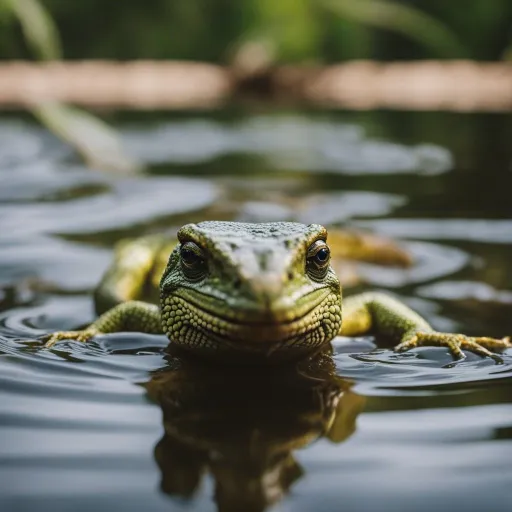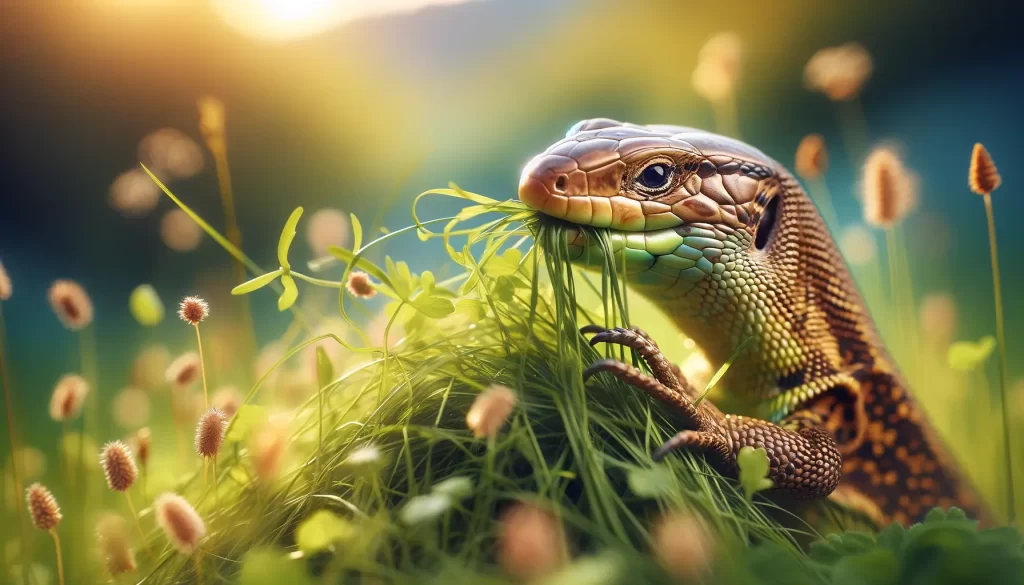So you’re curious about the potential danger of encountering lizards in Florida? Well, fear not, because we’ve got the scoop for you!
In this article, we’ll explore the question on everyone’s mind: are lizards in Florida poisonous?
Lizards in Florida are not poisonous; most species, including the commonly encountered anoles and geckos, are non-venomous and pose no immediate threat to humans.
So, let’s separate fact from fiction and uncover the truth about these scaly creatures lurking in the Florida wilderness.
Key Takeaways:
- Not all lizards in Florida are poisonous, but certain species can be toxic.
- Understanding the difference between poison and venom is crucial in evaluating lizard toxicity.
- Specific lizard species, such as the Gila monster and the Nile monitor, have been identified as having toxic saliva or venom.
- Safety precautions, such as avoiding handling lizards and seeking immediate medical attention if bitten, are important for minimizing the risk of encountering harmful lizard species.
- Conservation efforts and promoting coexistence with lizards can help protect native lizard species and maintain a balanced ecosystem.
Types of Lizards in Florida
Florida is home to a diverse range of lizard species, each with its own unique characteristics and adaptations.
Let’s explore some of the most common types of lizards you may come across in Florida.
Anole Lizards
Anole lizards are perhaps the most well-known lizards in Florida. These small, agile lizards can change their skin color, allowing them to blend into their surroundings.
The most commonly found anole species in Florida is the Green Anole, which can be seen perching on trees and shrubs.
Another common species is the Brown Anole, which was introduced from Cuba and has become widespread in Florida.
Skink Lizards
Skink lizards are characterized by their smooth, shiny scales and cylindrical bodies.
Five-lined Skinks, as the name suggests, have five distinct light lines running down their bodies. These lizards are commonly found in wooded areas, gardens, and around houses.
They primarily feed on insects and small invertebrates.
Gecko Lizards
Geckos are another group of lizards frequently encountered in Florida. These small, nocturnal lizards have specialized toe pads that allow them to climb vertical surfaces with ease.
The most common species of gecko in Florida is the Mediterranean Gecko, which can often be found hiding around outdoor lights or inside buildings.
Iguanas
Iguanas, particularly the Green Iguana, have become an increasingly common sight in Florida.
These large, herbivorous lizards are often seen basking in the sun on tree branches or rocks.
While Green Iguanas are non-venomous, they can inflict painful bites if threatened or handled improperly. It’s important to exercise caution when interacting with these majestic reptiles.
Monitor Lizards
Monitor lizards refer to a group of large lizards known for their elongated bodies, powerful tails, and keen hunting abilities.
The Nile Monitor, an invasive species, can sometimes be found in certain areas of Florida. These voracious predators can present a threat to native wildlife and should be reported if spotted.
Glass Lizards
Glass lizards, also known as legless lizards, are aptly named for their fragile-looking bodies and long, slender tails.
Contrary to popular belief, glass lizards are not snakes but rather a type of lizard. These lizards may drop their tails when threatened as a defense mechanism, similar to some types of geckos.
Five-lined Skinks
Five-lined Skinks, as mentioned earlier, are a type of skink lizard found in Florida. They are characterized by their distinct light lines running down their bodies.
Five-lined Skinks predominantly inhabit wooded areas and are frequently spotted sunning themselves on tree trunks or boulders.
Slender Glass Lizards
Slender Glass Lizards are another type of glass lizard found in Florida. They are similar in appearance to other glass lizards, with long, slender bodies and the ability to drop their tails if threatened.
Slender Glass Lizards can be found in a range of habitats, including sandy areas, grasslands, and pine forests.
Now that we have explored the various types of lizards in Florida, let’s delve into the topic of venomous lizards and the potential risks they pose.
Venomous Lizards in Florida
While venomous lizards are not commonly encountered in Florida, it’s essential to be aware of their existence for your safety and well-being.
Let’s explore some of the venomous lizards that can be found in Florida.
Explanation of Venomous Lizards
Venomous lizards possess specialized glands that produce venom, which they use to immobilize or kill their prey.
While venomous lizards can potentially harm humans, bites are rare, and deaths are extremely uncommon.
It is crucial to exercise caution and avoid direct contact with these reptiles.
Gila Monster
One of the notable venomous lizards found in the United States is the Gila Monster.
Although primarily found in the southwestern region of the country, it is not unheard of to encounter a Gila Monster in Florida.
These lizards have a unique pattern of bright orange and black scales, serving as a warning signal of their venomous nature.
Gila Monsters are typically slow, docile reptiles and only bite in self-defense.
Mexican Beaded Lizard
The Mexican Beaded Lizard shares a similar venomous classification to the Gila Monster.
This lizard is native to Mexico but is occasionally found in parts of southern Florida due to human introductions or accidental escapes.
Mexican Beaded Lizards are large, heavy-bodied creatures and have distinct, bumpy scales that resemble beads.
Like the Gila Monster, their bites are rare and typically occur when they feel threatened.
Other Venomous Lizards
While Gila Monsters and Mexican Beaded Lizards are the most well-known venomous lizards, there are other species that can potentially inflict venomous bites.
These include the Heloderma suspectum cinctum, a subspecies of the Gila Monster, and certain types of monitor lizards.
However, it’s important to note that encounters with these venomous species are extremely rare and unlikely.
Now that we have explored the venomous lizards, let’s switch gears and focus on the non-venomous lizards that are far more commonly encountered in Florida.
Non-Venomous Lizards in Florida

The majority of lizards found in Florida are non-venomous and pose no immediate threat to humans.
Let’s discover some of the non-venomous lizard species you may encounter in the Sunshine State.
Explanation of Non-Venomous Lizards
Non-venomous lizards lack the specialized venom-producing glands found in their venomous counterparts.
While they may be intimidating in appearance, these lizards primarily rely on camouflage, agility, or other means of defense to survive.
Green Anole
The Green Anole, also known as the Carolina Anole, is one of the most recognizable lizards in Florida.
These small lizards are a vibrant green color and can change their skin color to brown or even gray, depending on their mood or environmental conditions.
Green Anoles are often found in trees and shrubs, where they hunt for insects and mate.
Brown Anole
The Brown Anole, native to Cuba, has become extraordinarily abundant in Florida. These lizards are adaptable and can be found in various habitats, including urban areas and natural habitats.
Brown Anoles are typically brown in color and have a distinctive dewlap, which is a throat fan used for communication and courtship displays.
Cuban Brown Anole
The Cuban Brown Anole is a subspecies of the Brown Anole and is commonly found in southern Florida.
These lizards have a similar appearance to their mainland relatives but are often darker in coloration, featuring a series of light bands or stripes running down their bodies.
Cuban Brown Anoles are highly adaptable and can thrive in both urban and natural environments.
Knight Anole
The Knight Anole is among the largest lizards you may encounter in Florida. These impressive reptiles can grow up to two feet long and are predominantly green in color.
Knight Anoles are native to Cuba and have been introduced to certain parts of Florida, predominantly in Miami-Dade County.
They are typically found in tropical environments, such as gardens, parks, and the edges of forests.
Eastern Fence Lizard
The Eastern Fence Lizard, although not as well-known as the Green Anole or Brown Anole, is a common sight in Florida.
These lizards have rough, spiky scales and are primarily brown or gray in color. Eastern Fence
Lizards can be found in various habitats, including forests, open fields, and even suburban backyards.
Now, let’s explore the key differences between venomous and non-venomous lizards in terms of their physical and behavioral characteristics, as well as the symptoms and effects of their bites.
Key Differences between Venomous and Non-Venomous Lizards
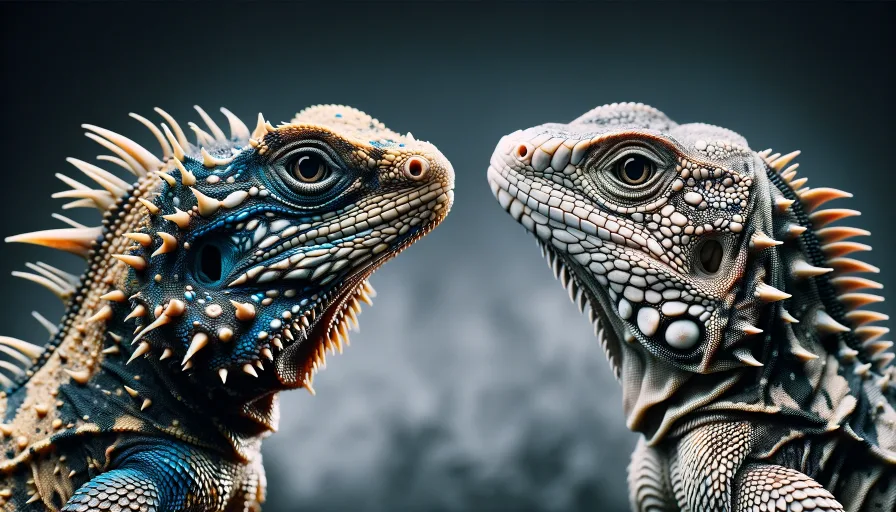
Understanding the differences between venomous and non-venomous lizards is crucial for ensuring your safety and dispelling common misconceptions.
Let’s examine these differences in terms of physical characteristics, behavior, and the symptoms and effects of bites.
Physical Characteristics
Venomous lizards, such as Gila Monsters and Mexican Beaded Lizards, typically possess colorful scales with distinctive patterns, acting as a visual warning to potential predators.
They may have bumpy or beaded scales, which can be a unique identifier. In contrast, non-venomous lizards, including Green Anoles and Brown Anoles, often exhibit various shades of green, brown, or gray for camouflage purposes.
The presence or absence of specialized venom-producing glands is another significant physical difference between venomous and non-venomous species.
Behavioral Characteristics
Venomous lizards are more likely to exhibit a defensive behavior if they feel threatened.
They may hiss, puff up their bodies, or open their mouths wide to display their teeth and warning colors.
Non-venomous lizards, on the other hand, may attempt to escape or remain still, relying on their camouflage to avoid detection.
It’s important to note that not all defensive behaviors indicate venomous properties, as even some non-venomous lizards can display aggressive actions.
Bite Symptoms and Effects
Bites from venomous lizards can cause a range of symptoms, including severe pain, swelling, redness, and potentially systemic effects such as nausea or dizziness.
However, it’s crucial to remember that bites from venomous lizards are exceptionally rare, and fatalities are even rarer.
Non-venomous lizard bites are typically harmless and may result in minor puncture wounds or scratches, similar to injuries caused by a cat or dog bite.
By understanding these key differences, you can better determine the potential risks associated with lizard encounters and dispel common misconceptions.
Common Misconceptions about Lizards in Florida

There are several misconceptions surrounding lizards in Florida that often lead to unnecessary fear or misunderstandings.
Let’s address some of these misconceptions and provide accurate information.
All Lizards in Florida are Poisonous
This is one of the most common misconceptions about lizards in Florida. The truth is, the majority of lizards in the state, including the well-known Green Anole and Brown Anole, are non-venomous and pose no immediate threat to humans.
Venomous lizards, such as Gila Monsters and Mexican Beaded Lizards, are extremely rare and encounters are uncommon.
All Venomous Lizards are Deadly
Another common misconception is that all venomous lizards are deadly. While it’s true that venomous lizards have the potential to harm humans, bites and envenomation are extremely rare.
Fatalities from venomous lizard bites are even rarer. It is important to exercise caution and avoid direct contact with venomous lizards, but there is no need to live in fear or panic if you see a lizard in Florida.
Non-Venomous Lizards Cannot Harm Humans
While non-venomous lizards are generally harmless, it is possible for them to bite humans if they feel threatened or cornered.
Non-venomous lizard bites typically result in minor puncture wounds or scratches, similar to injuries caused by a cat or dog bite.
It’s important to treat these bites promptly to prevent infection and practice proper handling techniques to minimize the risk of being bitten.
Now that we have clarified these misconceptions, let’s explore the potential dangers associated with lizards in Florida.
Potential Dangers of Lizards in Florida
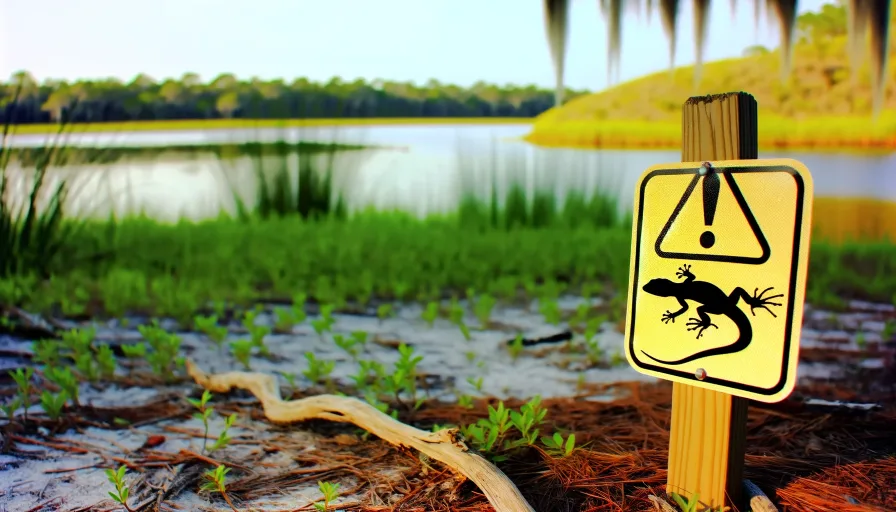
While the majority of lizards in Florida pose no immediate danger to humans, there are a few potential risks to be aware of. Let’s examine these potential dangers to ensure your safety.
Bites or Scratches
While non-venomous lizard bites are generally harmless, they can still cause minor puncture wounds or scratches that should be cleaned and treated promptly to prevent infection.
It’s important to exercise caution when handling or interacting with lizards to minimize the risk of being bitten or scratched.
Transmission of Salmonella
Lizards, like many reptiles, can carry the bacteria Salmonella in their digestive systems. While healthy lizards typically do not show symptoms, they can potentially shed the bacteria in their feces.
Therefore, it’s essential to practice good hygiene, such as washing hands thoroughly after handling lizards or cleaning their enclosures, to minimize the risk of contracting Salmonella.
Impact on Ecosystem
Invasive lizard species, such as Green Iguanas, can have a negative impact on Florida’s ecosystem.
These invasive species can outcompete native wildlife for resources and disrupt the natural balance of ecosystems.
It’s crucial to report any sightings of invasive species and support conservation efforts to protect native lizard populations.
To minimize these potential dangers, there are some precautions you can take when dealing with lizards in Florida.
Precautions to Take in Dealing with Lizards in Florida
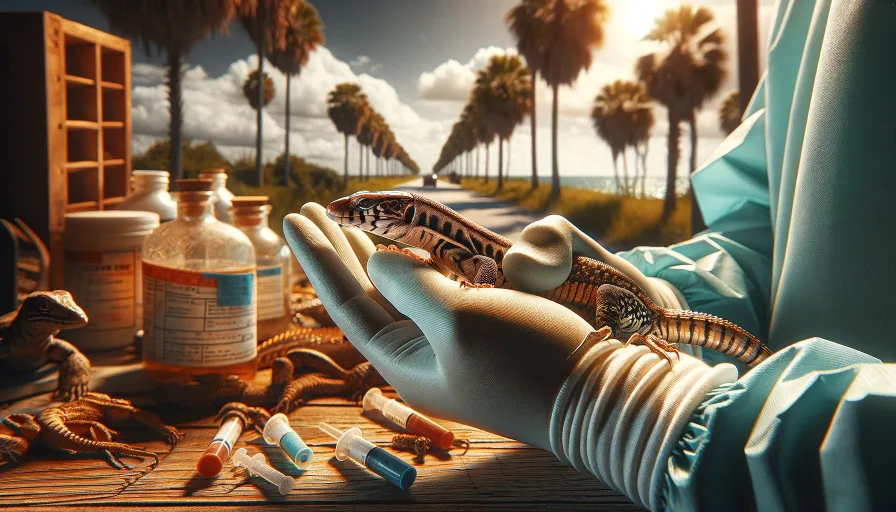
Taking simple precautions when interacting with lizards in Florida can help ensure your safety and foster a harmonious coexistence.
Let’s explore these precautions in detail.
Avoiding Direct Contact
It’s advisable to avoid direct contact with all lizards, both venomous and non-venomous, to minimize the risk of bites or scratches.
Observe lizards from a safe distance and allow them to go about their natural behaviors undisturbed.
This not only protects you but also ensures the well-being of the lizards.
Proper Handling Techniques
If you need to handle a lizard, such as during rescue or relocation efforts, it’s important to learn proper handling techniques from experts or professionals.
Handling small lizards can be more challenging, as they are more delicate and agile. Always approach lizards calmly and gently, avoiding sudden movements that may startle or stress them.
Maintaining Hygiene
To reduce the risk of contracting any potential pathogens from lizards, it is essential to maintain good hygiene practices.
Wash your hands thoroughly with soap and water after handling lizards, cleaning their enclosures, or coming into contact with their feces.
This simple habit can help prevent the transmission of bacteria such as Salmonella.
Securing Outdoor Spaces
To avoid unwanted interactions with lizards, particularly invasive species like Green Iguanas, it’s essential to secure outdoor spaces.
Ensure that fences and barriers are in good condition to keep lizards out of areas where they may cause damage or pose a potential threat.
Now that we have covered precautionary measures, let’s explore what to do in the event of a lizard bite and how to administer first aid.
Lizard-Bite First Aid
While lizard bites are rare and typically harmless, it’s essential to know how to identify a lizard bite and provide appropriate first aid. Let’s walk through the necessary steps.
Identifying a Lizard Bite
A lizard bite may result in minor puncture wounds or scratches on the skin. The bite marks will typically be small and may show signs of bleeding or swelling.
It’s important to remember that venomous lizard bites are extremely rare, and most bites are from non-venomous species that pose no immediate threat.
Immediate Actions
In the event of a lizard bite, it’s crucial to stay calm and take immediate action. Gently cleanse the bite area with mild soap and water to minimize the risk of infection.
Apply a clean, dry bandage or dressing to the wound to keep it protected.
Seeking Medical Help
While most lizard bites do not require medical attention beyond basic first aid, it is advisable to seek medical help if the bite shows signs of infection, such as increasing redness, swelling, or pus.
Additionally, if the bite is from a venomous lizard, it is essential to seek immediate medical attention, even if symptoms appear mild or nonexistent.
Staying Calm
In the event of a lizard bite, it’s important to stay calm and not panic. Remember that lizard bites are generally harmless, and seeking appropriate medical help for severe symptoms or signs of infection is the best course of action.
Now that we have covered first aid for lizard bites, let’s explore conservation efforts aimed at protecting lizards and their natural habitats in Florida.
Conservation Efforts for Lizards in Florida
Conservation efforts play a crucial role in protecting native lizard species and their delicate ecosystems.
Let’s explore some of the initiatives focused on safeguarding lizards in Florida.
Protecting Native Lizard Species
Conservation organizations and government agencies work together to protect and conserve native lizard species in Florida.
Efforts include preserving and restoring natural habitats, such as forests and wetlands, which provide vital resources for lizards.
Protecting these habitats ensures the long-term survival of native lizard populations.
Controlling Invasive Species
Invasive lizard species, such as Green Iguanas, pose a significant threat to native wildlife.
Conservation efforts involve implementing control measures to minimize the impact of invasive species on the environment.
These measures may include trapping, relocating, or managing invasive populations, thereby reducing competition and preserving the biodiversity of native lizard species.
Preserving Natural Habitats
Preserving natural habitats is crucial for the overall conservation of Florida’s lizard populations.
Efforts are made to create and maintain protected areas, such as wildlife refuges and national parks, where lizards can thrive undisturbed.
Additionally, educational programs raise awareness about the importance of preserving and respecting these habitats to ensure the survival of native lizard species.
By supporting these conservation efforts and promoting a greater understanding of lizards in Florida, we can contribute to the long-term conservation of these fascinating reptiles.
Final Thoughts
In conclusion, Florida is home to an array of lizard species, each with its own unique characteristics and adaptations.
While venomous lizards do exist, encounters with them are exceptionally rare, and bites are even rarer. The majority of lizards in Florida are non-venomous and pose no immediate threat to humans.
By understanding the key differences between venomous and non-venomous species, dispelling common misconceptions, and taking necessary precautions, we can coexist safely with these fascinating reptiles.
Remember, respect their habitats, maintain good hygiene practices, and foster a sense of appreciation for the diverse lizard species found in the beautiful state of Florida.



